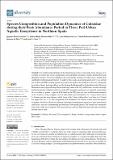Por favor, use este identificador para citar o enlazar a este item:
http://hdl.handle.net/10261/334433COMPARTIR / EXPORTAR:
 SHARE SHARE
 CORE
BASE CORE
BASE
|
|
| Visualizar otros formatos: MARC | Dublin Core | RDF | ORE | MODS | METS | DIDL | DATACITE | |

| Título: | Species Composition and Population Dynamics of Culicidae during their Peak Abundance Period in Three Peri-Urban Aquatic Ecosystems in Northern Spain |
Autor: | Ruiz-Arrondo, Ignacio; Alarcón-Elbal, Pedro María; Blanco-Sierra, Laura; Delacour-Estrella, Sarah; Blas, Ignacio de; Oteo, José A. | Palabras clave: | Culicidae Diversity ITS2 Mosquito La Rioja Anopheles claviger sensu stricto Upper Ebro Valley |
Fecha de publicación: | 18-ago-2023 | Editor: | Multidisciplinary Digital Publishing Institute | Citación: | Diversity 15(8): 938 (2023) | Resumen: | For a better understanding of the transmission cycles of mosquito-borne diseases, it is essential to explore the species composition and population dynamics, mainly during their peak abundance period. These investigations do not normally include peri-urban areas, despite their significant epidemiological interest. To address these gaps, an entomological survey was carried out in 2016 and 2017 in three aquatic ecosystems located on the outskirts of the city of Logroño, in northern Spain: the Iregua River and La Grajera (La Rioja) and Las Cañas Reservoirs (Navarra). Mosquitoes were captured using BG-Sentinel traps baited with CO2 and BG-lure, as well as through the human landing collection method. In total, 6793 mosquito specimens were captured, representing 24 taxa within six genera. A specific PCR based on the ITS2 gene was used to differentiate members of the Anopheles claviger complex, and all individuals were identified as An. claviger sensu stricto. La Grajera had the most diverse culicid fauna, with 19 taxa, followed by Las Cañas (n = 15) and the Iregua River (n = 13). The composition and abundance of Culicidae varied across the aquatic ecosystem. We observed that the different hydrological management practices of each environment could play a key role in determining the abundance of mosquito genera. The overall risk of mosquito bites in the study area is expected to be relatively low and will depend on the freshwater ecosystem and the time of year. | Versión del editor: | https://doi.org/10.3390/d15080938 | URI: | http://hdl.handle.net/10261/334433 | DOI: | 10.3390/d15080938 | E-ISSN: | 1424-2818 |
| Aparece en las colecciones: | (CEAB) Artículos |
Ficheros en este ítem:
| Fichero | Descripción | Tamaño | Formato | |
|---|---|---|---|---|
| Species_Composition_Ruiz.pdf | 2,76 MB | Adobe PDF |  Visualizar/Abrir |
CORE Recommender
Page view(s)
44
checked on 30-abr-2024
Download(s)
13
checked on 30-abr-2024
Google ScholarTM
Check
Altmetric
Altmetric
Este item está licenciado bajo una Licencia Creative Commons

